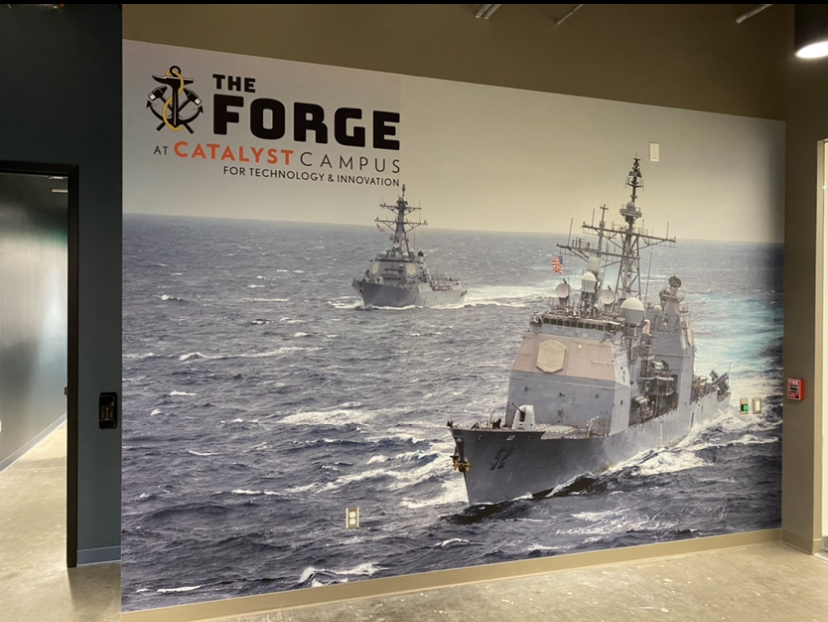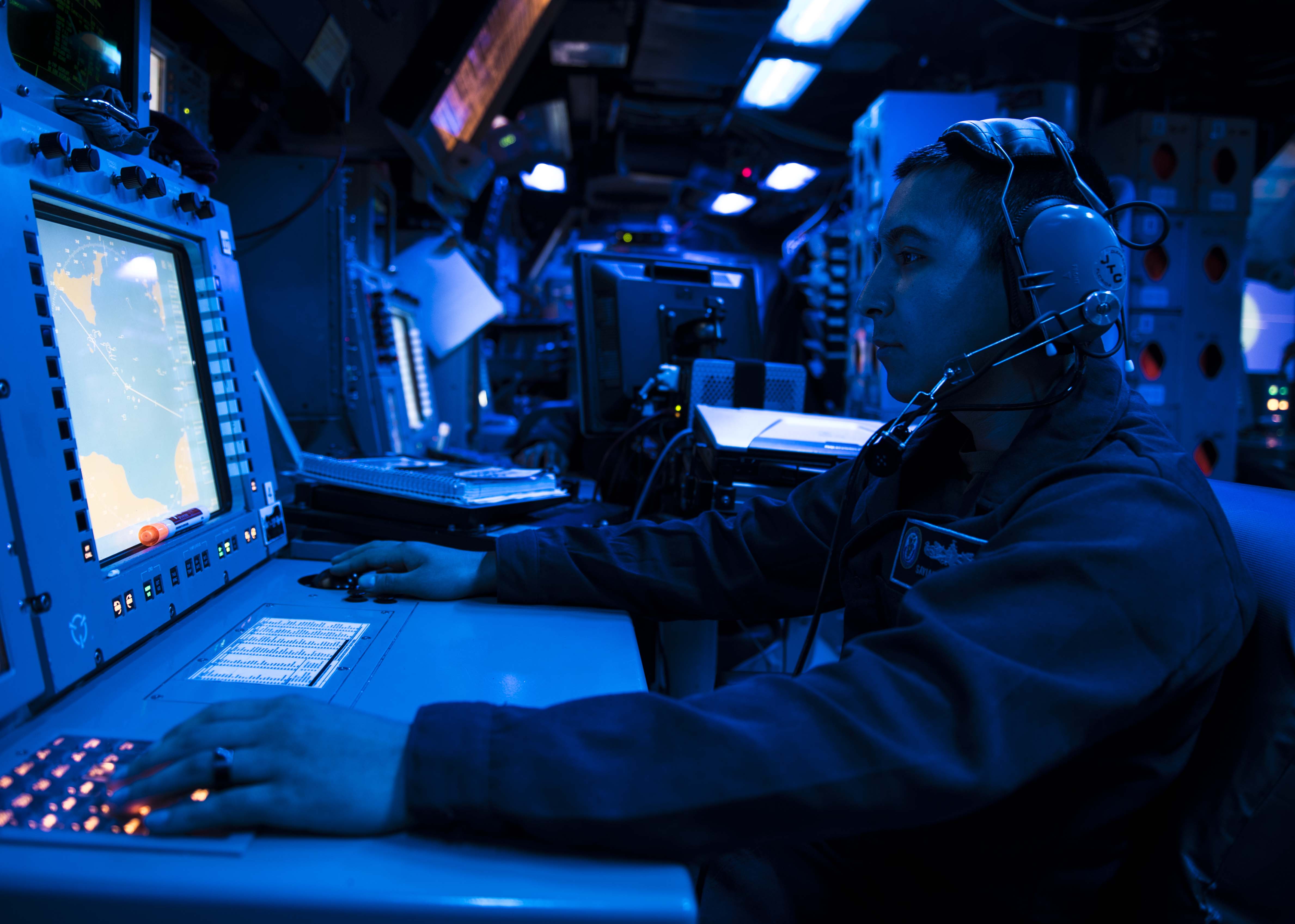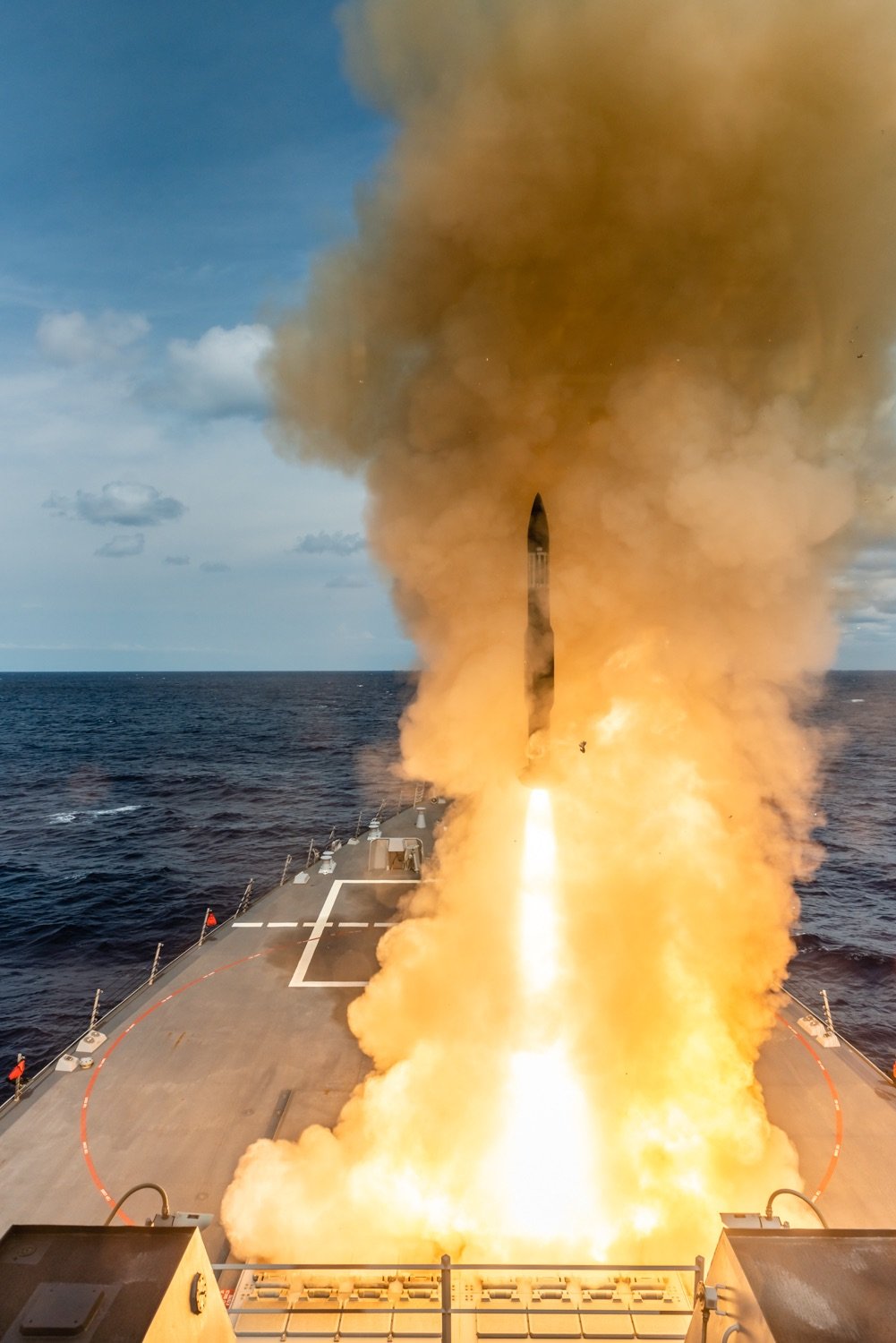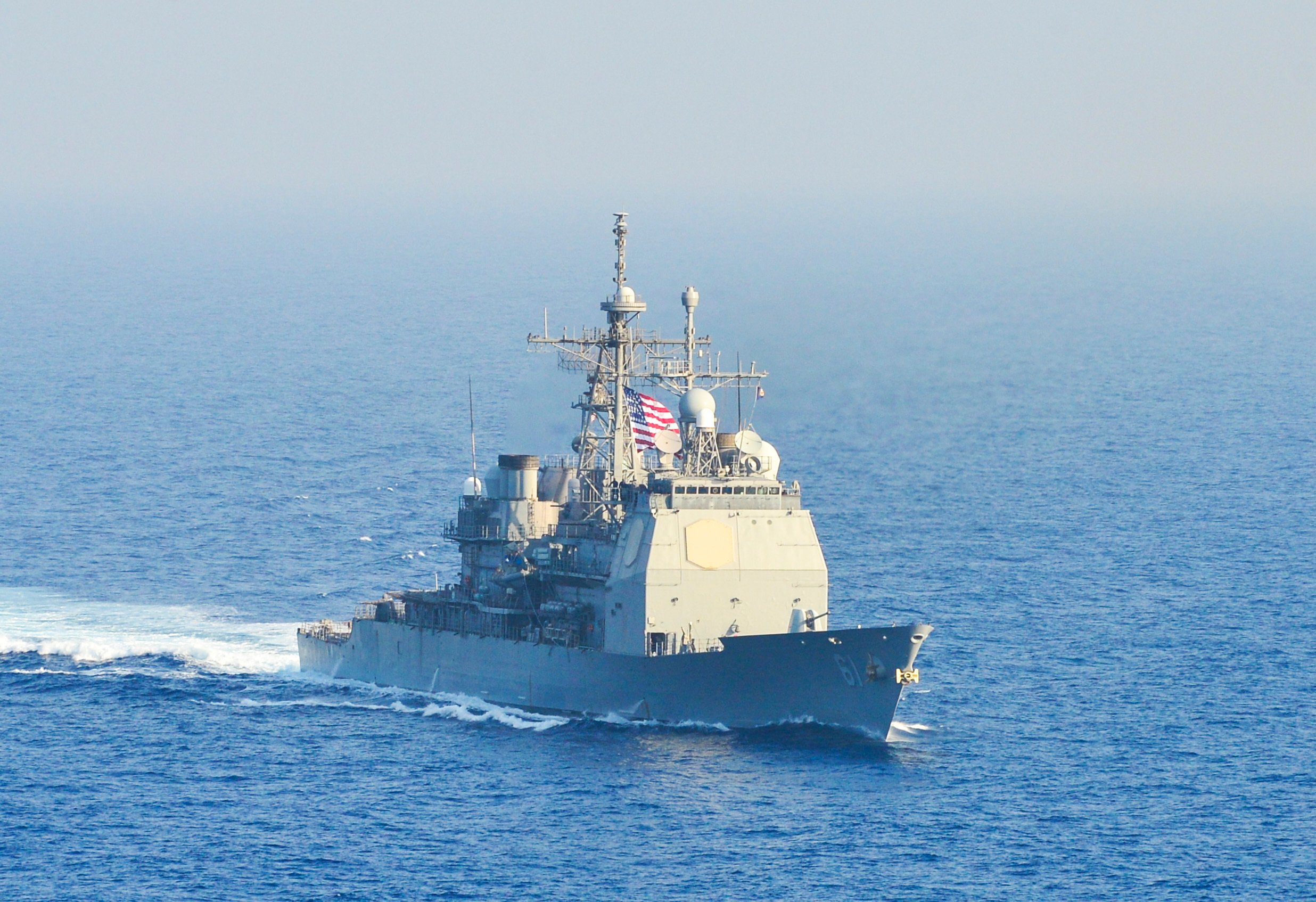
RIVERDALE, Md. – The Navy’s potential enemies are quickly increasing the size and sophistication of their fleets, which means the Navy needs to move faster too in bringing in new capabilities.
The sea service envisions a new way of doing business where it can field software fixes and entirely new software-based capabilities piecemeal, as soon as they’re developed by a small business or research team, instead of waiting for a large package of updates to all be ready to go in a more traditional update approach.
Long ago, a ship was only as capable as it was built to be – or as capable as it was made in a complex and intrusive overhaul period.
The software-based Aegis Combat System has helped, though the process of developing, testing and fielding entire baselines of new capabilities still has been slow at times.
The submarine community honed a tight spiral development process for bringing in new hardware and software every few years, which other communities have tried to emulate – but today, the surface community is ditching the development cycle altogether, with the standup of The Forge software factory that promises solutions to the fleet’s problems in months or weeks instead of years, one admiral told USNI News.
The Forge recently stood up in a sleek office space just off the University of Maryland College Park campus, with an open layout that will soon host teams from the defense industry, small business, government and academia – all taking a new approach to quickly solving the Navy’s problems and outfitting sailors with new and more lethal capabilities through rapid software development, certification, testing and fielding.
Rear Adm. Seiko Okano, the program executive officer for integrated warfare systems who oversees The Forge, said three factors led the Navy to stand up this new software development and fielding ecosystem: the threat is advancing faster than the Navy’s current processes can keep up with; the service is pursuing a Naval Operational Architecture to net together ships and aircraft that requires a “force-level integrated combat system” that can’t be created affordably through traditional means; and the digital revolution has made things like digital engineering and virtual twins more commonplace.
All these factors together, she said, lead the Navy to “transition from building these big, monolithic Aegis baselines, which took years, lots of money, one contractor” to instead pursue a government-led effort where a lot of companies and research teams are working on pieces of a Navy-managed and -owned effort. If the Navy can create a software-development environment that already has government-mandated cyber security built into it, that reduces the barrier for small companies, university teams, non-defense companies and more to participate if they’re the best ones to tackle a small slice of the overall effort, Okano said.
“I think that’s really where you see The Forge kind of flourish, which is, again, building that ecosystem where we handle the cybersecurity, we handle all the tools; they come in with their algorithms or their ideas or their code, and we basically build the pipeline to the fleet.”
At The Forge, the Navy has created a space where cybersecurity is ensured upfront; software writers can come in and work alongside Navy technical authorities and testers from the outset, meaning a new algorithm will never get too far without any serious flaws being detected. Development, testing and certification happen in tandem, with a pipeline already in place to quickly get that code to a land-based test site and then to a ship for at-sea testing.
Okano said The Forge would start with some smaller projects to prove the process works and to gain confidence, and then start tackling bigger warfighting needs once the Navy and industry are comfortable with what she calls a culture change.

One example of an early project has to do with maintenance.
After the Navy and prime contractor Lockheed Martin spend years of effort to develop and field a new baseline of the Aegis Combat System, she said, sailors will inevitably find things that are annoying, difficult or not intuitive – and these discoveries all lead to software trouble reports. Okano said those reports are passed along to the Navy and Lockheed Martin, where they wait until work begins on the next Aegis baseline. The Navy determines how many of those reports it can afford to fix based on budgets and what other capabilities the new baseline needs to incorporate, and meanwhile sailors are living with known software flaws for years before they can be addressed.
With The Forge, Okano said she hopes to address those software trouble reports as they come in. Totally separate from the baseline development process – which in theory should be focused on adding new capability rather than fixing flaws in old capabilities – Okano said The Forge could tackle those problems with a team from government, industry and academia and field them as soon as the fixes are ready, rather than waiting for an artificial timeline tied to baseline development.
“I just challenge the team, can you do that in months? Can you do that in weeks?” Okano said.
Right now, personnel at The Forge are mostly from the government – from Naval Surface Warfare Center Dahlgren Division, from the Johns Hopkins University Applied Physics Laboratory and from federally funded research and development centers – but Okano said the Navy has awarded some other transaction authority (OTA) contracts to bring in industry and small business, who will start showing up in the next couple months.
Once they have some early wins that prove the process works, Okano said they’d begin using The Forge to add more combat capability to ships and work towards achieving a fleet-wide integrated combat system.

For years, this would have been unthinkable: surface combatants had the Aegis Combat System, and aircraft carriers and amphibious warships had the Ship Self-Defense System, and the two were separate and incompatible Now, Okano said, the Aegis system has been virtualized – the capability has been replicated with software and totally separated from the hardware – and the Navy is working on virtualizing SSDS next. Though Raytheon originally built SSDS, Lockheed Martin has since won a contract to manage SSDS and will take its experience virtualizing Aegis and apply it to the second combat system.
“What you really want is to bring that all together, so now you don’t have an SSDS or an Aegis; you have an integrated combat system that is force-wide,” Okano said.
For this to work, all the ships would need to have a virtual twin installed. A virtual twin is the same combat system software that runs on the ship, but contained within a separate, small hardware package. The Navy has been able to prove that the virtual twin, when plugged into a ship’s sensors and weapons, can perform just as well as the actual combat system in detecting and defeating incoming threats. As a result, Okano said the Navy could feel comfortable using a virtual twin on a ship to test new software from The Forge before putting the software on the ship’s real combat system.
“Virtualization was that first step of separating out the hardware and the software and was foundational to this. I think the next step was the virtual twins, and that was really our USS Monterey (CG-61) pilot. … A lot of the work that The Forge is doing is going to go onto the Monterey first because we’ve got a virtual twin – so essentially what you really want are virtual twins on all Aegis ships; you have some sort of code that comes out of The Forge; it gets containerized, over the air pushed to ships at sea; it goes onto the virtual twins; those virtual twins then test that out, running in the background – so you’ve got the tactical software just running, but then in the background you’ve got this new software that’s getting tested out as well (to create) additional data to show us, hey, is this working the way we intended it to. And then at some point, hey, if we have enough evidence that the data is stable and is working, then they can cut over that code and now you have that capability faster.”
The Navy has plans to put virtual twins on all ships that go through a tech refresh period to receive the Baseline 9 Aegis upgrade. Okano said the service is considering putting virtual twins on ships with older combat systems, too.
“This is a really good, in my opinion, a really good opportunity of taking some of the older baselines and upgrading them fairly fast with the virtual twin. But again, it’s starting with Baseline 9 and tackling that baseline first,” she said.

If The Forge can generate new code that can be tested or even operated from a virtual twin plugged into a ship at sea, Okano said the effort could scale up from addressing maintenance fixes to adding combat capability to even creating great leaps in capability by allowing the combat system to incorporate artificial intelligence and machine learning (AI/ML), for example, or bringing unmanned systems into the integrated combat system structure.
“If the process works right – and again, knowing that we’ve got that Naval Operational Architecture – pulling in capabilities like [the Task Force Overmatch and the Joint All-Domain Command and Control (JADC2) networks], and new capabilities in general, whether that’s directed energy – I think that’s really where we want to get to,” Okano said.
“At some point, we’ve got to also figure out the AI/ML piece, where we’re going to start creating these big data lakes – how do you analyze that very quickly and get AI and ML into the combat system smartly. Those are kind of our north stars. We’ve got to start with maintenance, and I think figuring out, again, the pipeline, and then how do we start inchstoning ourselves to those bigger goals.”
Asked about challenges to achieving that vision, Okano said all the requisite technology exists, but she said the Navy and industry – and Congress – will have to adjust to a new way of doing business.
While she’s excited to get out of the model of relying on new baselines or the submarine community’s ARCI cycle to refresh software, “there’s something to be said about cycles only because I think it matches the budgets and all that other stuff, so we’re going to do a lot of learning. And this is also a discussion that we’ve got to have with Congress and with [the chief of naval operations’ staff] and everything else on, here’s kind of our intention: the intention is we’ve got to get capability out to the fleet as fast as we can, as affordably as we can. We think we’ve got a way; we’re going to start testing it out. How does this fit into the budget process?” she said.
“And that discussion is ongoing. I think ARCI cracked it in that they had a level-loaded amount of funding every year, but that’s something that we’ve got to figure out.”
She said she and PEO IWS need to convince Congress that the money will be well spent. Though she understands lawmakers worry about risk, “we don’t want this to fail either, so how do we do this smartly, how do we do this in bite-sized chunks where we’re not betting the farm, but we are kind of shifting the rudder over a little bit.”
“It is going to require some change, some culture change, on both sides” for government and industry, Okano continued, but “we’re in a budget-constrained environment, and frankly we don’t have a lot of time.”
Though there might be a perception that moving quickly introduces risk, Okano said the DEVSECOPS process – where development, security and operators are all in a closed feedback loop for continuous development and improvement – is a great model that will get the Navy to a more competitive place.
“Better and faster aren’t opposed from each other. And I think sometimes people think, oh, you’re going to lose rigor, or you’re going to not be as disciplined. And I actually think you’re more rigorous because you’re testing early and often, you’re certifying early and often, instead of it being at the very end and then trying to fix the stuff that you have to fix. Let’s just fix it from the beginning and then continue to fix that,” Okano said.
“So I actually think it’s more rigorous over time. But certainly, the goal is continuous delivery and integration and faster capability to the fleet.”





